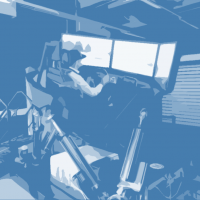Driving simulator motion cueing optimization
Driving simulation is an important part of many research, testing and training programs. The motion that is reproduced by the simulator is controlled by the motion cueing algorithm (MCA), which aims at providing drivers with a similar experience as to what they would perceive in its real vehicle equivalent. The inevitable differences to the real vehicle experience, due to the limited size of simulators, makes MCA design a difficult task. Over the years, research in this area has progressed towards solutions where optimization-based algorithms become possible, such as Model-Predictive Control (MPC) algorithms, compared to the widely adopted filter-based Classical Washout Algorithm (CWA).
Although MPC algorithms have shown to generally provide drivers with a higher motion quality than CWA, it is still an open question whether the former is always the best solution given a specific use-case. Optimization-based algorithms are, for example, often more difficult to implement, have a higher computational load and might not even be always necessary if a high motion quality is not the most important requirement for a given experiment or use-case. Furthermore, larger simulators might be better at exploiting the qualities of MPC algorithms, where for smaller simulators the differences between the algorithms becomes negligible. The latter point becomes especially important in the BMW simulation center currently under construction in Munich, Germany. In a few years, it will operate fourteen different simulators, with different purposes, capabilities and limitations. A core question to be answered is which experiments are best performed on which simulator and, if motion is an important aspect, which MCA configuration is to be used. This question requires a multi-dimensional approach, in which implementation aspects must be compared with, for example, predicted motion cueing quality.
As a first step towards such an approach, BMW and TU Delft have developed a flexible software environment and methodology in which different motion cueing algorithms configurations and simulators can be systematically evaluated, such that the best-suited combination of hardware and software can be chosen.


